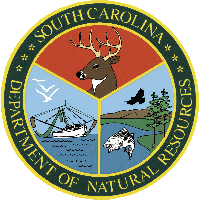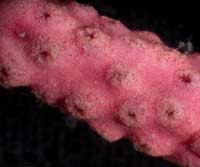CONTENTS
Introduction
The South Atlantic Bight
Methods
Octocoral Morphology
Glossary
Gorgonacean
Bauplan
see this for keys
Notes on the Species
Carijoa
riisei
Scleranthelia
rugosa
Telesto fruticulosa
Telesto nelleae
Telesto sanguinea
Bellonella rubistella
Pseudodrifa nigra
Nidalia occidentalis
Iciligorgia schrammi
Diodogorgia
nodulifera
Titanideum
frauenfeldii
Muricea pendula
Thesea nivea
Bebryce cinerea
Bebryce parastellata
Scleracis guadalupensis
Paramuricea sp.
Leptogorgia hebes
Leptogorgia punicea
Leptogorgia
cardinalis
Leptogorgia virgulata
Leptogorgia setacea
Leptogorgia euryale
Viminella
barbadensis
Renilla reniformis
Sclerobelemnon
theseus
Stylatula elegans
Virgularia presbytes
| Guide
to the Shallow Water (0-200 m) Octocorals of the South Atlantic
Bight.
S. T. DeVictor
& S. L. Morton, 2007
Thesea nivea Deichmann,
1936 Remarks. This species branches
more or less in one plane with slender branches that bend upward,
sometimes at an abrupt 90-degree angle. In life, the colony is reddish
violet, with dark red to purple polyps that often have white centers.
Under magnification, the tissue of the polyps and coenenchyme is
violet, but colorless sclerites are visible on the surface of the
stems and at the base and neck of the expanded polyps. When preserved
in alcohol the coenenchyme color is a gray, creamy white or light
brown. The conical calyces are scattered around the branches and
have a visible eight-lobed star. The branches are 3-4 mm in diameter
and tips on some branches are slightly inflated. This species may
be fouled with epibionts such as ascidians and barnacles, and often
has multiple galls per colony that are occupied by invertebrates
such as the spionid worm Polydora sp. and the crab Pilumnus
floridanus (pers. obs.). Atlantic distribution: North Carolina to South Carolina, 24-49 m; Dry Tortugas, 71 m; St. Lucia, 371 m; Guadalupe, 358 m (type) (Deichmann, 1936; NMNH collections; SERTC collection).
Note: In addition to the identified specimens examined, one Thesea specimen was collected and examined but unidentified. The specimen is approximately 63 cm in height with a lateral branching growth form. All stems appear to be 1-2 mm in width and gently curving upward from the main stem. The calices are moderately protruding and domelike with retractile polyps. The most obvious character about this specimen is the sclerites, which range from 0.1 mm to over 1 mm in length. The largest of the sclerites are bluntly elongate to globular deposits with two distinct sides. The outer side displays undulating, irregular humps which are quite smooth with the exception of the clusters of low, fine spines at the apex of each hump. The opposing side, which tends to face the axis, displays a very coarse texture and crowded, fine tubercules. The smaller sclerites tend to be concentrated toward the calices and are warty, elongate spindles with acute tips. All sclerites are coral red with the exception of the yellow opercular rods. Although several of the Thesea species in Deichmann (1936) are described as having large, ridged or undulating outer sclerites, no mention is made of sclerites with such a contrasting texture. |
|
 |



